Key Points:
- Out of 22 snake species found in New Jersey, two are venomous and dangerous to humans.
- Black snakes are common in the state, and black colored species include the northern water snake, black rat snake, and Northern and southern ringneck snakes.
- Timber rattlesnakes, which can be black at times, are an endangered species in New Jersey, with remaining populations in the northern area along the Kittatinny Ridge and in the southern region in the Pine Barrens.
New Jersey is the most densely populated state in the United States, meaning it has the most people packed into the smallest space. With all those people is there even room for wildlife? Does New Jersey have snakes?
There are parks and wildlife in New Jersey, including snakes, so if you are hiking on the “Stairway to Heaven” in Sussex County and you see a black snake skitter across the trail, should you be alarmed? Let’s find out about the black snakes in New Jersey!
How Many Kinds of Snakes Are in New Jersey?
There are 22 different species of snakes in New Jersey. You may be surprised to learn that two of the species are venomous snakes: the northern copperhead and the timber rattlesnake. Just to make things interesting one of the venomous snakes can be black — sometimes!
Which Venomous New Jersey Snake Is Black … Sometimes?

Timber rattlesnakes can be tan with dark brown markings or they can be black.
©Frode Jacobsen/Shutterstock.com
The timber rattlesnake goes through a yellow phase where it is tan to yellow with dark brown markings and a black phase where it turns dark brown or black and has faint markings. So, how can you tell if the black snake you see is venomous?
The timber rattlesnake is a pit viper and has a rattle at the end of its tail. It also has a triangular head holding two hollow fangs that fold up into its mouth. If you can see the eyes in bright light, the pupils are vertical, like cat eyes and there will be two small holes on either side of their head, pits, that help them sense prey. Keeping your distance from all snakes is the safest course of action.
Let’s find out more about all the black snakes.
1. Timber Rattlesnakes (Crotalus horridus)
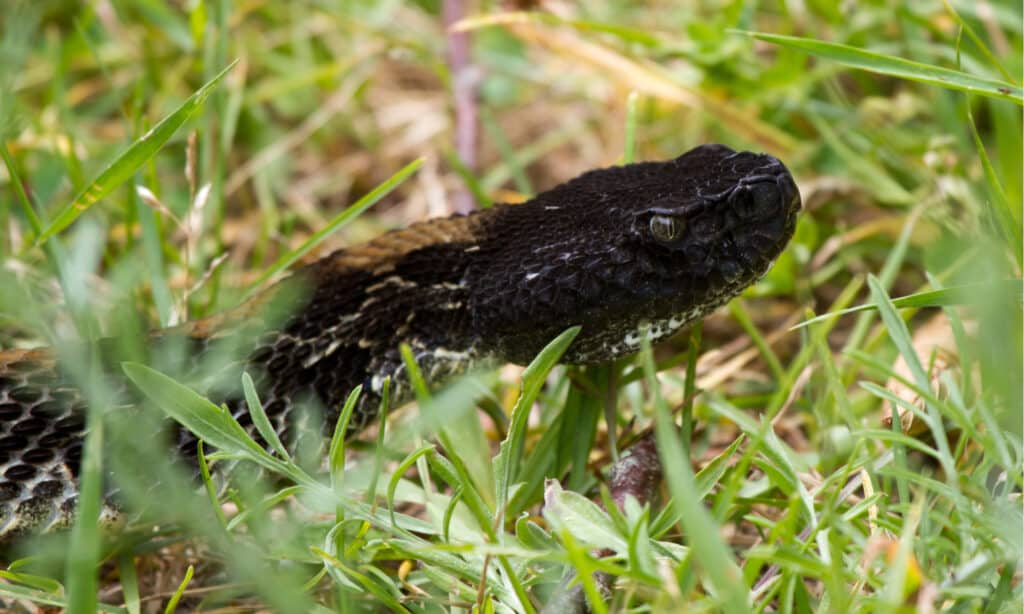
Melanism is common and timber rattlesnakes can look very dark with darker patterns running across their body.
©Frode Jacobsen/Shutterstock.com
Timber rattlesnakes are large, heavy-bodied snakes that grow 36-60 inches (3-5 feet) long and can weigh 1-3 lbs. Their coloration varies so some are tan or yellowish with dark brown markings while others are black.
In New Jersey, they are an endangered species so it is unlikely you would come across one. The remaining populations are in the northern area along the Kittatinny Ridge and in the southern area in the Pine Barrens. Timber rattlesnakes prefer rocky, wooded areas as well as swamps and forests.
2. Northern Water Snakes (Nerodia sipedon)
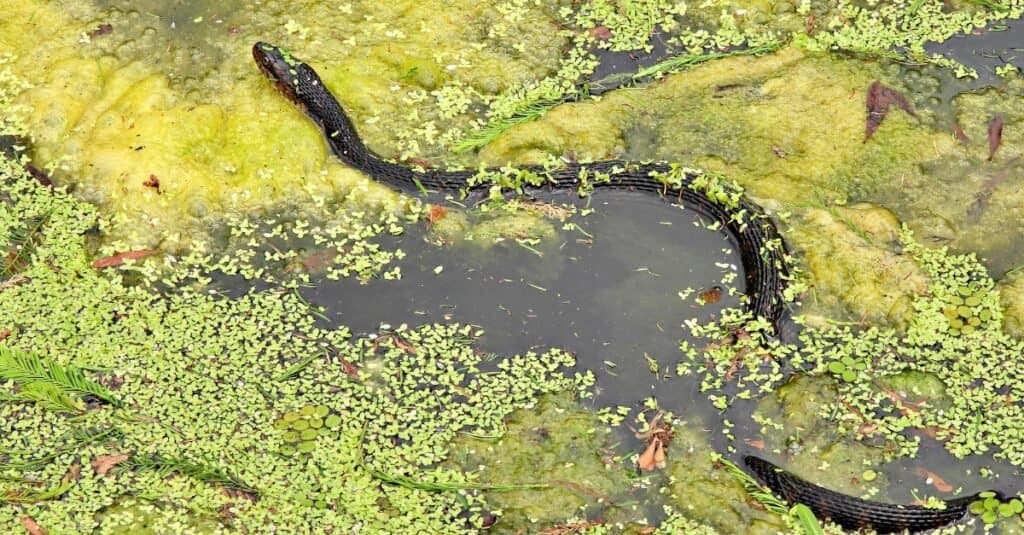
Northern water snakes are common a common black snake in New Jersey. They can be found in lakes, ponds and ditches.
©iStock.com/passion4nature
The northern water snake is one of the most common snakes in all of New Jersey. As the name suggests, this snake that lives in and around water including lakes, ponds, ditches, and slow-moving rivers. The northern water snake is 24-50 inches long and a heavier-bodied snake. They can be a lighter color with dark brown “reverse-hourglass” markings, but as they get older they get darker and some are black. They are common throughout New Jersey.
3. Black Rat Snakes (Pantherophis alleghaniensis)

The black rat snake is the biggest black snake in New Jersey at 3.5-7 feet long!
©iStock.com/RCKeller
The black rat snake is the largest snake found in New Jersey. They can get to be 3.5-7 feet long and are muscular, but harmless. Adults are all black except for a white chin and when they move you can see white in between their scales, the remnants of their juvenile pattern. If you thought you would be safe hiking by scanning the ground around rocks and crevices you should probably add a few glances to the surrounding trees.
Black rat snakes are excellent climbers and can be found “hanging out” in tree branches. If you accidentally scare one you may know it right away because they emit a really foul smell! They are found throughout the state but mainly in rural and suburban areas.
4. The Northern Black Racer (Coluber constrictor)
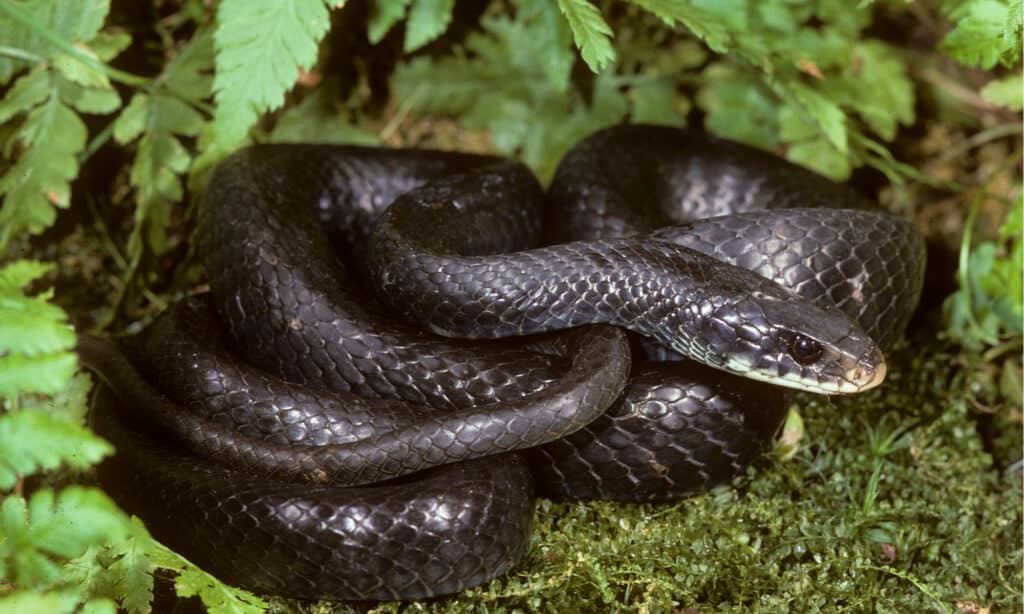
Black racers are commonly found across New Jersey.
©Breck P. Kent/Shutterstock.com
The northern black racer is a shiny black snake that is long and skinny. They are called racers because they are fast! They average 36-60 inches in length and are all black with a white chin. You may be fooled by the northern black racer into thinking they are a rattlesnake because they cleverly imitate rattlers by wagging their tail against brush or rocks to create a rattling noise. They live in the same habitat as black rat snakes and can be found throughout the state in rural and suburban woods and fields.
5. Northern Redbelly Snake (Storeria occipitomaculata)
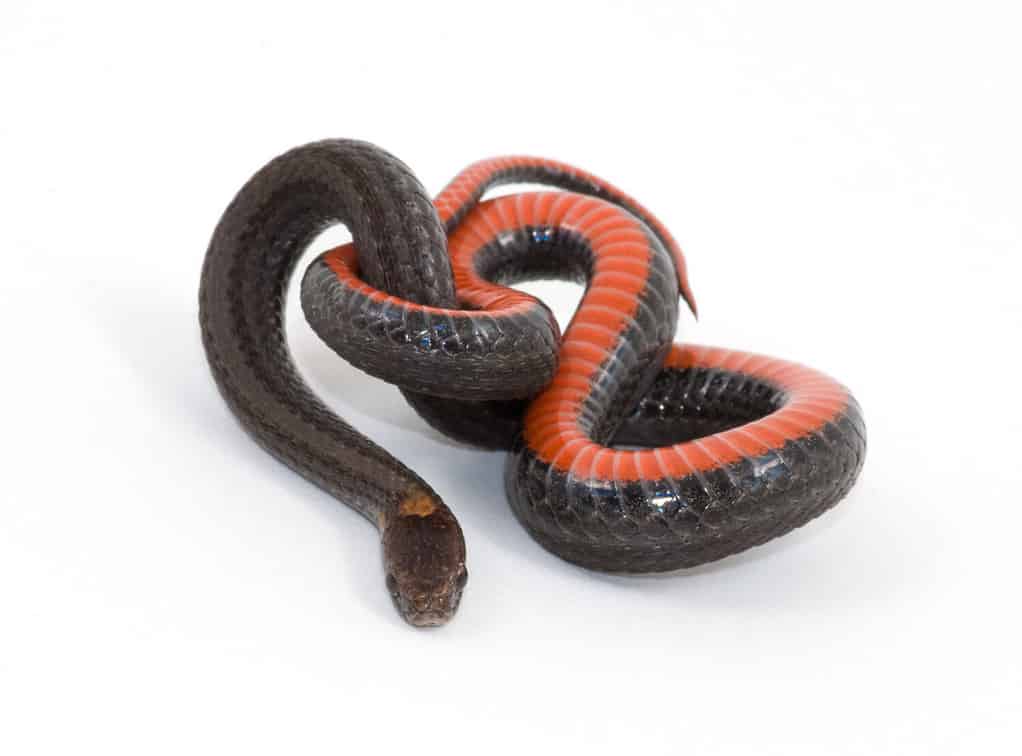
Red-bellied snakes are cousins to Dekay’s brownsnake.
©Gerald A. DeBoer/Shutterstock.com
As the name implies the northern redbelly has a red underside, but its back is all black. Their bellies can be reddish or orangish as well. These tiny snakes are a little bigger than large earthworms at 8-16 inches long. Because of their size, they are not commonly seen, but they are common throughout the state. They prefer wooded areas, bogs and open fields for their habitat.
6. Northern Ringneck Snakes (Diadophis punctatus edwardsii)
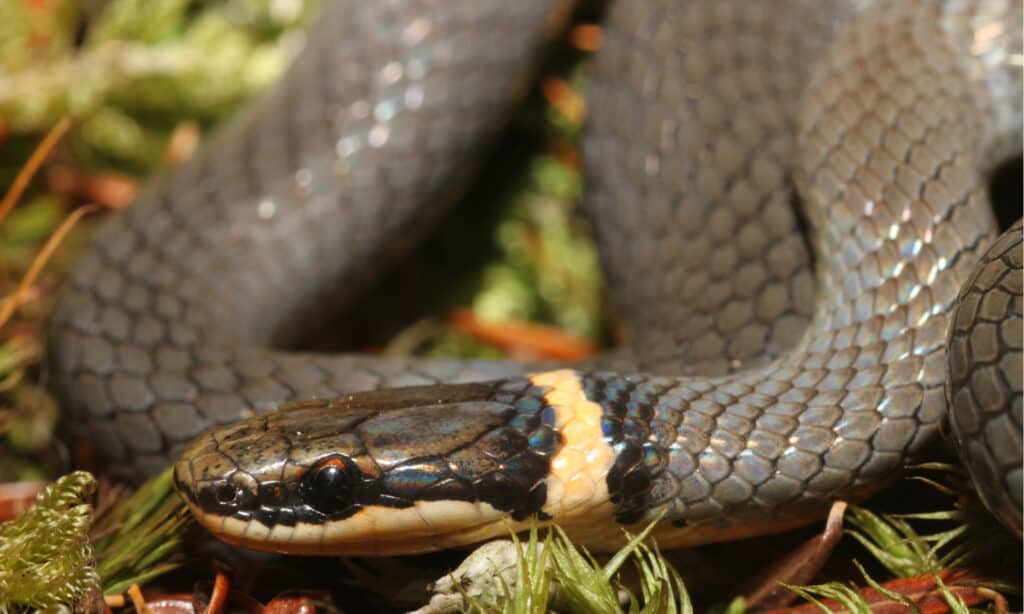
The northern ringneck has a collar-like ring around its neck.
©/Shutterstock.com
Another small snake at 10-30 inches and skinny, these snakes are all black except for a collar-like ring around their necks. The collar is usually a golden yellow and matches the belly color. Northern ringneck snakes like to hide under rocks, logs and brush and can be found throughout the state.
7. Southern Ringneck Snakes (Diadophis punctatus punctatus)
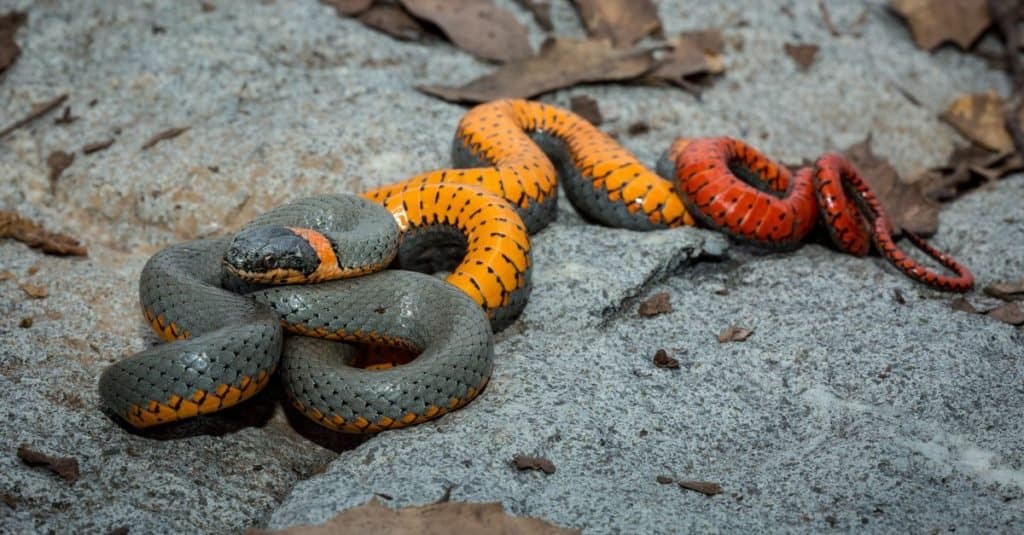
Ringneck snakes will play dead when threatened.
©Michael K. McDermott/Shutterstock.com
Similar to the northern ringneck, these snakes have a ring around their neck like a collar. They have the same coloration as well, but have additional half-moon black markings on their belly. Southern ringnecks are a tad smaller with the average being 6-18 inches long. They can be found hiding under rocks and logs as well but prefer moister soil and habitats. The southern ringneck is one of the smaller black snakes in New Jersey.
8. Eastern Garter Snake
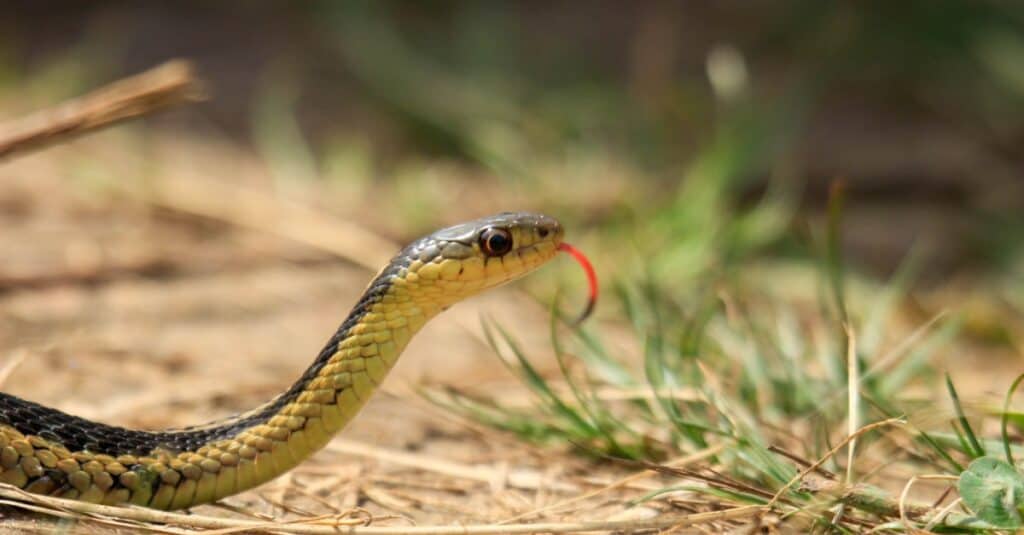
Foxes, raccoons, pigs, turkeys, and guinea hens are some of the natural predators of snakes.
©iStock.com/mynewturtle
The eastern garter snake is one of the most common snakes spotted around homes. Most garter snakes have three long stripes going down the length of their body. So, if you see a black snake with three long yellowish stripes it is probably a common garter. However, some garter snakes don’t have stripes and some have dark brown stripes, so those snakes may look all black at first glance. Garter snakes can be found throughout the state and live in fields, meadows and suburban backyards.
Are Any of the Black Snakes in New Jersey Dangerous?
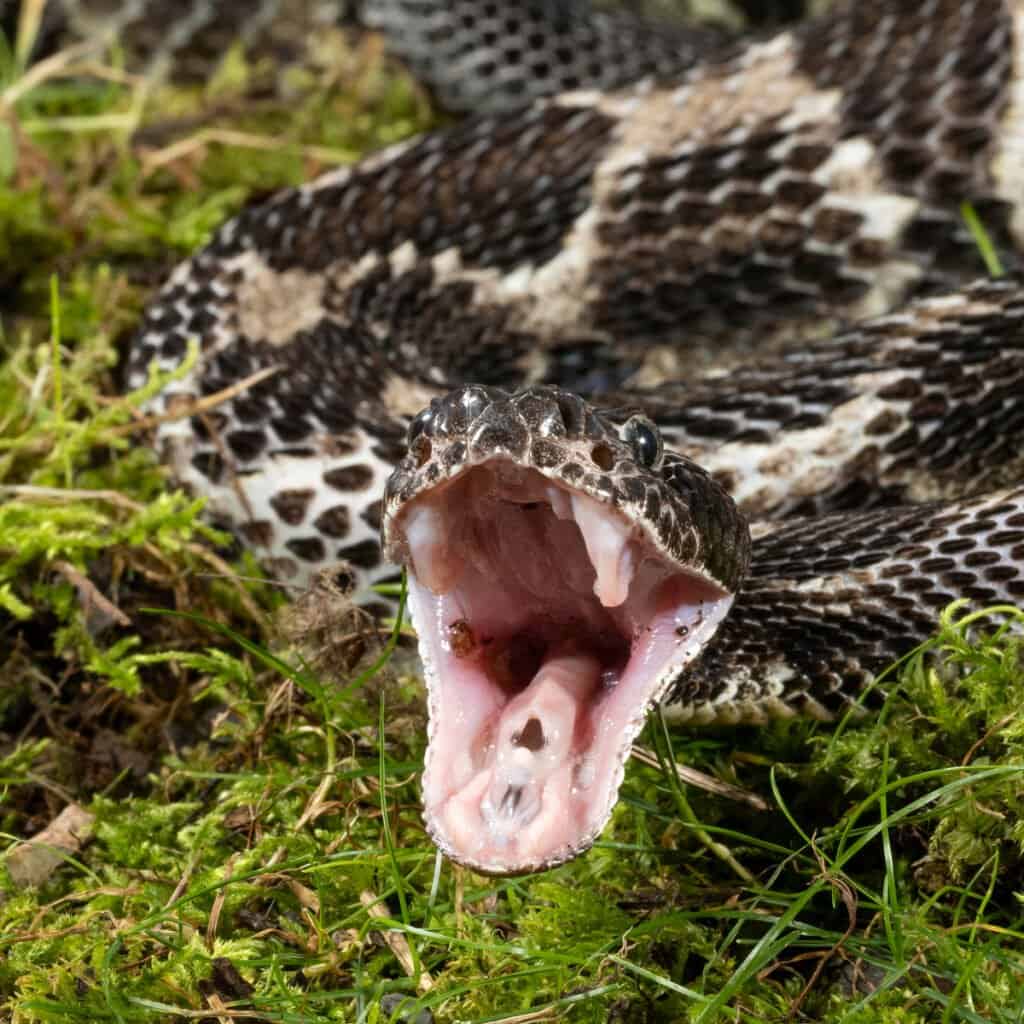
Some snakes in New Jersey are dangerous, including the timber rattlesnake.
©Joe McDonald/Shutterstock.com
Yes, all black snakes are capable of biting, but only the timber rattlesnake (and the northern copperhead, which is not black) is venomous and injects toxic venom into their target. Most snakes prefer to stay away from humans and will either slither away or stand guard and give warning. Never handle a snake in the wild. They can respond with a quick bite and some, like the timber rattler, can deliver a fair amount of venom in one bite. If you do get bitten you should seek immediate medical attention.
Luckily, snake bites, especially venomous ones, are very rare in New Jersey and no one has ever reportedly died from one in the state. However, this doesn’t mean it can’t happen. Snakes blend well with their environment and excellent camouflage can lead to human-snake encounters. If this occurs, do not make sudden movements or approach the snake. Move slowly away from the snake while keeping an eye on it until you are out of sight. If bitten, call 911 or poison control for information and follow their directions until at a hospital. If you cannot identify the snake, safely try to snap a photo to show medical professionals or, if the snake is dead, safely transport the carcass with you to show them.
Five Fascinating Facts About Black Snakes
- Timber rattlesnakes can live over 30 years!
- Northern water snakes are nonvenomous, but they look similar to the highly venous snake: the water moccasin. Many are killed by humans due to this mistake.
- Black rat snakes are great to have around the outside of your home for pest control! These nonvenomous friends feed on mice and other small rodents.
- When ringneck snakes feel threatened, they coil their tails and point them at the potential threat.
- Though the eastern garter snake is considered nonvenomous, it has a Duvernoy’s gland that secretes fluid into its prey during bites. This causes hemorrhaging in mice.
Summary of Black Snakes in New Jersey
| Number | Snake | Coloration |
|---|---|---|
| 1 | Timber Rattlesnake | Black and brown stage |
| 2 | Northern Water Snake | Brownish, get darker with age |
| 3 | Black Rat Snake | Dorsally black; Ventral/head/beneath scales is white |
| 4 | Northern Black Racer | Black body, white chin |
| 5 | Northern Redbelly Snake | Black dorsal; Lateral/ventral/mouth red to orange ombre |
| 6 | Northern Ringneck Snake | Black with rainbow iridescence; White “collar” ring around upper neck; Yellow belly |
| 7 | Southern Ringneck Snake | Black with white collar; Orange/red belly with half-moon markings |
| 8 | Eastern Garter Snake | All black or black with white/brown/yellow stripes |
The photo featured at the top of this post is ©
Discover the "Monster" Snake 5X Bigger than an Anaconda
Every day A-Z Animals sends out some of the most incredible facts in the world from our free newsletter. Want to discover the 10 most beautiful snakes in the world, a "snake island" where you're never more than 3 feet from danger, or a "monster" snake 5X larger than an anaconda? Then sign up right now and you'll start receiving our daily newsletter absolutely free.
Thank you for reading! Have some feedback for us? Contact the AZ Animals editorial team.






